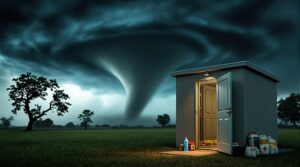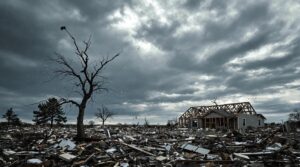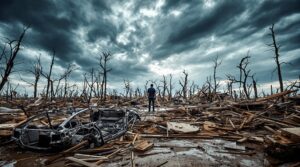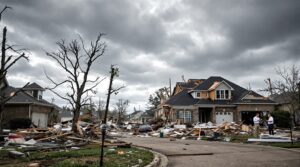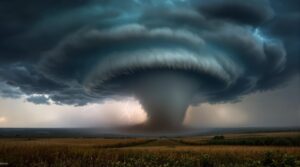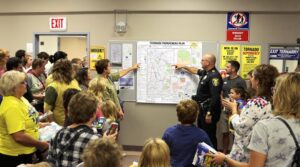EF4 tornadoes, generating wind speeds of 166-200 mph, represent approximately 2% of all recorded tornado events. These catastrophic storms cause extensive structural devastation, reducing well-built homes to debris piles and stripping foundations clean. From 2007-2017, 71 confirmed EF4 tornadoes resulted in 337 deaths and 4,556 injuries, chiefly occurring during April-May. Safety protocols mandate immediate shelter in basements or storm cellars. Understanding the complex atmospheric conditions and damage patterns enables enhanced preparedness and survival strategies.
Key Takeaways
- EF4 tornadoes generate wind speeds between 166-200 mph and comprise 2% of all recorded tornadoes, causing catastrophic structural damage.
- Well-built homes are reduced to debris piles, with complete roof removal and wall collapse common in residential structures.
- Safety measures include seeking shelter in basements or storm cellars and monitoring NOAA Weather Radio for emergency updates.
- Most EF4 tornadoes occur during April-May, primarily affecting states like Alabama, Oklahoma, Missouri, Georgia, and Tennessee.
- From 2007-2017, 71 confirmed EF4 tornadoes caused 337 deaths and 4,556 injuries across the United States.
Understanding EF4 Tornadoes: Classification and Wind Speeds
EF4 tornadoes represent one of the most violent classifications on the Enhanced Fujita Scale, characterized by wind speeds ranging from 166 to 200 mph and accounting for approximately 2% of all recorded tornadic events.
These devastating storms are equivalent to T8-T9 ratings on Europe's TORRO scale, demonstrating alignment between international tornado classification systems.
The Enhanced Fujita Scale incorporates 28 distinct damage indicators to assess wind speed measurement and storm intensity.
Well-constructed buildings and entire neighborhoods can be completely leveled by the sheer destructive force of an EF4 tornado.
This revised system addressed limitations in the original Fujita scale by implementing more precise correlations between observed damage and wind speeds.
The assessment process involves detailed damage surveys conducted by experts who analyze structural damage patterns and environmental impacts.
Wind speed estimates are derived through expert elicitation, combining engineering studies with extensive field experience.
This methodical approach guarantees accurate classification of these violent storms, which can completely destroy well-built structures and debark trees through their extreme force.
Observable Damage Patterns and Impact Assessment
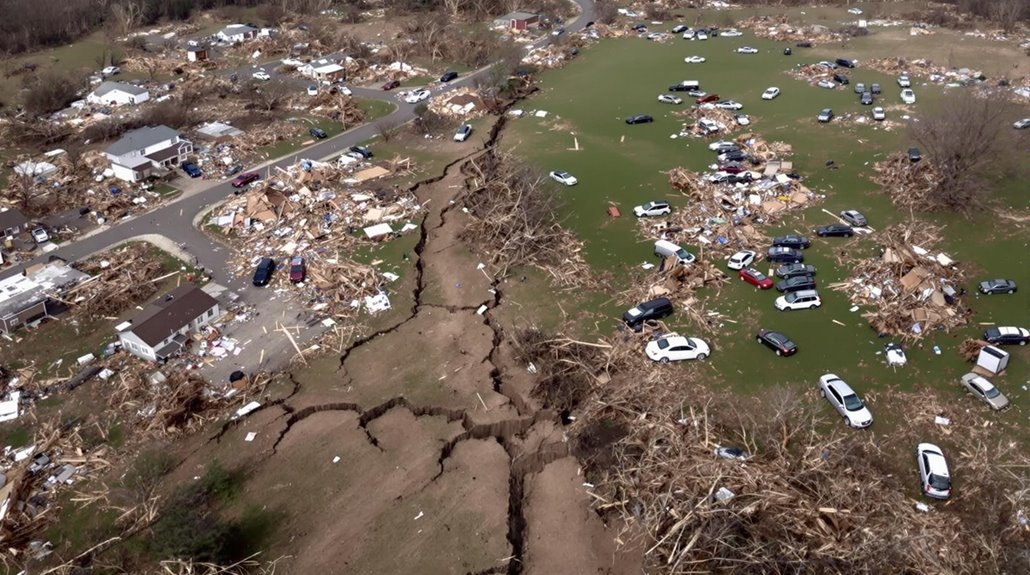
Structural collapse analysis of EF4 tornadoes reveals consistent patterns where well-built homes are reduced to debris piles and foundations are stripped clean of anchored materials.
Ground scarring assessments indicate extensive soil disruption patterns, with visible tracks showing the tornado's path through debarked vegetation and scattered structural components.
Vehicle displacement studies demonstrate that passenger cars can be thrown up to several hundred meters from their original locations, while larger vehicles like buses and trains may be rolled multiple times or lifted entirely off the ground. These violent tornadoes represent less than 1% of all recorded tornado events in the United States.
Structural Collapse Patterns
When evaluating tornado damage, observable collapse patterns serve as critical indicators for determining wind intensity and categorizing the event's severity.
In tornado aftermath scenarios, EF4 events demonstrate distinct structural failure signatures across various building types. Residential structures exhibit complete roof removal and exterior wall collapse, while well-anchored foundations may remain partially intact, indicating varying levels of structural resilience. These powerful storms produce 166 to 200 mph winds that contribute to the devastating structural failures observed.
Commercial and industrial facilities, even with steel reinforcement, can be completely flattened, while mobile homes and temporary structures typically disintegrate entirely.
The Enhanced Fujita Scale utilizes 28 specific damage indicators to assess wind speeds, with particular attention to debris distribution patterns and the extent of structural failure. This systematic analysis of collapse patterns enables precise categorization and aids in understanding the tornado's destructive force.
Ground Scarring Analysis
A thorough analysis of ground scarring patterns provides essential data for evaluating tornado intensity and path characteristics in EF4 events. The distinct treefall patterns exhibit backward convergence, with trees falling opposite to the tornado's translation direction, often accompanied by complete debarking and uprooting of large specimens.
Ground scarring analysis reveals severe vegetation damage, including extensive debarking of healthy trees and significant loss of wooded areas. The Rankine vortex model simulations demonstrate how these damage patterns develop during extreme wind events.
EF4 tornadoes create distinctive soil impact patterns, characterized by deep ground scarring from displaced vehicles and heavy objects. The distribution of debris fields further validates tornado intensity, as these violent storms can transport substantial objects over considerable distances.
These combined indicators form vital evidence for accurate damage assessment and wind speed estimation using the Enhanced Fujita Scale.
Vehicle Displacement Evidence
Vehicle displacement patterns in EF4 tornadoes demonstrate distinct characteristics that serve as essential indicators for damage assessment and wind speed estimation.
Analysis reveals that while some vehicles are completely lifted and thrown distances exceeding 10-15 yards, most experience pushing or rolling motions across shorter distances. During vehicle recovery operations, investigators document displacement patterns, noting that larger vehicles like trucks and buses show increased susceptibility to wind effects. Specialized vehicles like the TIV are engineered with steel plate floors to withstand these extreme conditions.
Debris analysis of vehicle distributions typically shows scattered patterns within proximity to original locations, though this varies with terrain features and surrounding structural elements.
The interaction between vehicles and other debris contributes to thorough damage assessments, helping meteorologists validate wind speed estimates ranging from 166 to 200 mph. These observations serve as significant damage indicators within the Enhanced Fujita Scale classification system.
Statistical Analysis of EF4 Events (2007-2017)
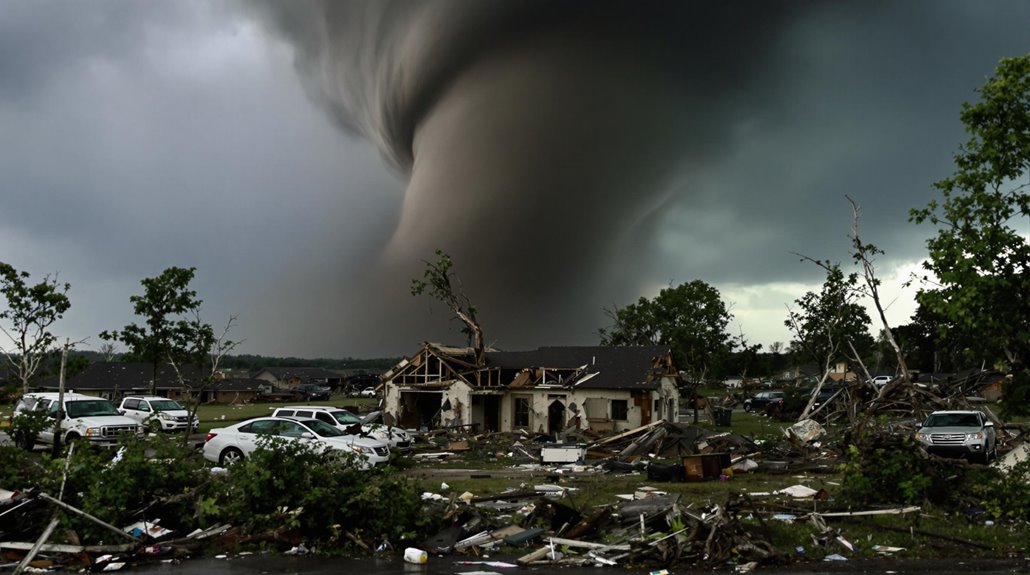
Between 2007 and 2017, the United States recorded 71 confirmed EF4 tornadoes, averaging approximately 7 events annually. The tornado frequency peaked markedly in 2011, with 31 EF4 tornadoes documented that year. Fatality analysis indicates 337 deaths and 4,556 injuries during this period, with the deadliest event occurring on April 27, 2011, in Alabama.
Statistical data from this decade reveals several critical patterns:
- The April-May timeframe exhibited the highest concentration of severe outbreaks.
- Geographic distribution spanned multiple states, with notable clusters in Alabama, Oklahoma, Missouri, Georgia, and Tennessee.
- Wind speeds consistently ranged between 166-200 mph.
- The most catastrophic events occurred during the 2011 tornado season.
These EF4 events demonstrated consistent characteristics of devastating damage, including complete structural failure of well-built homes and the transformation of vehicles and medium-sized objects into dangerous projectiles.
Analysis indicates that multi-vortex formations, such as the 2007 Northwood case, contributed to enhanced damage potential.
Critical Safety Measures During an EF4 Tornado

Based on the statistical severity of EF4 tornadoes documented from 2007-2017, implementing precise safety protocols can greatly reduce casualty risks during these catastrophic events.
Primary tornado preparedness strategies emphasize seeking refuge in basements or storm cellars, which provide ideal protection against the intense wind forces characteristic of EF4 tornadoes.
When subterranean shelter is unavailable, occupants must relocate to interior rooms on the lowest building level, maintaining maximum distance from windows and exterior walls. Emergency communication plans should incorporate NOAA Weather Radio updates and predetermined evacuation routes.
Mobile home residents must evacuate immediately to sturdy structures, as manufactured housing provides insufficient protection against EF4-level winds.
Post-event protocols require systematic assessment of injuries, hazards, and structural damage while maintaining communication with emergency services. Individuals should remain in their designated shelter locations until authorities confirm the threat has passed.
Historical Significance and Notable EF4 Occurrences

Throughout recorded history, EF4 tornadoes have demonstrated consistent destructive potential, with documented cases dating back to the London tornado of 1091 that destroyed 600 houses and damaged the Church of St Mary-le-bow.
Historical tornadoes of this magnitude have shown similar patterns of devastation across multiple continents, with considerable tornado impact documented in Europe, North America, and Asia.
Notable historical EF4 events have exhibited these characteristic patterns:
- Multiple-vortex structures causing widespread structural failure
- Ground scouring indicating extreme wind velocities
- Complete destruction of well-built structures
- Path lengths frequently exceeding 100 kilometers
Research continues to refine our understanding of historical tornadoes, as evidenced by recent reclassifications.
The 2022 Gretna-Arabi-New Orleans East tornado, initially rated EF3, showed damage patterns consistent with EF4 intensity upon further analysis.
International documentation of EF4 events has improved considerably since 1950, providing valuable data for understanding these extreme weather phenomena and their impact on different geographical regions.
Weather Conditions That Spawn EF4 Tornadoes
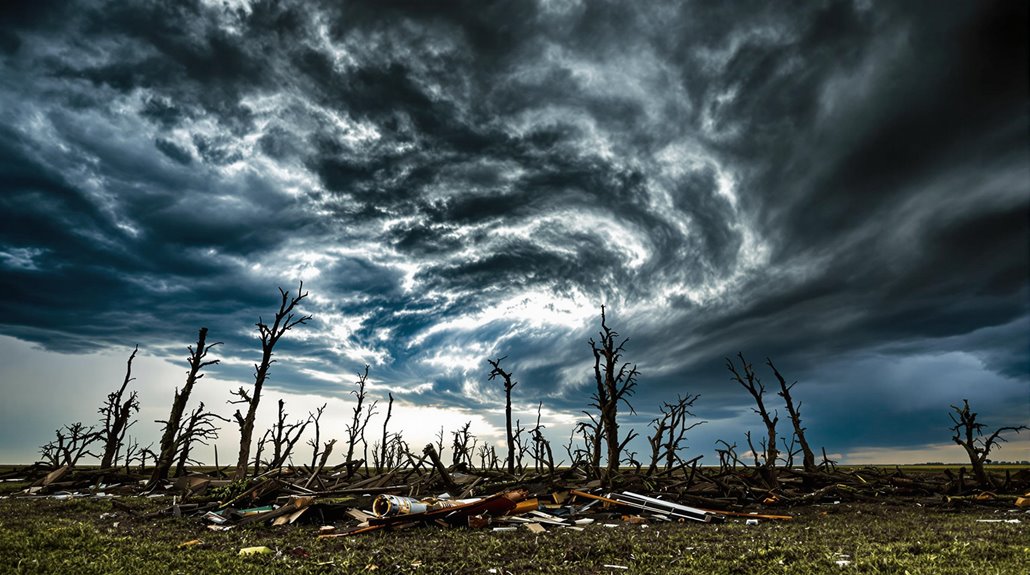
The formation of EF4 tornadoes requires specific atmospheric conditions within supercell thunderstorms, including vertical wind shear of approximately 50 mph between surface winds and those at 18,000 feet.
These violent tornadoes develop when warm, moist air near the ground interacts with cooler, dry air aloft, creating mixed-layer CAPE values between 2,500 and 4,500 j/kg.
The presence of streamwise vorticity and strong mesocyclone rotation, combined with significant low-level moisture content, establishes the environment necessary for EF4 tornado development.
Supercell Storm Requirements
When powerful supercell storms develop under specific atmospheric conditions, they can spawn devastating EF4 tornadoes through a complex interaction of wind shear, temperature gradients, and moisture content.
Supercell dynamics require moderate to strong wind shear between the surface and 20,000 feet, with speed differences of approximately 50 mph creating the necessary rotation for tornado formation.
Critical atmospheric requirements include:
- Temperature decrease of 30°F per mile over several miles
- High relative humidity near the surface with cloud bases around 2,000 feet
- Persistent rotating updraft (mesocyclone) maintained by wind shear
- Streamwise vorticity in air parcels to intensify rotation
The combination of these elements, particularly the interaction between instability and wind shear in the lowest half-mile, distinguishes environments capable of producing violent tornadoes from less severe conditions.
Perfect Moisture-Temperature Mix
Creating ideal conditions for EF4 tornadoes requires a precise interplay between moisture content and temperature gradients within the atmosphere. High relative humidity near the ground, supplied by moisture sources such as water bodies and surface evaporation, combines with specific temperature profiles to generate the necessary instability for severe tornadic development.
The process involves warm, moist air meeting cold, dry air masses, creating powerful updrafts within thunderstorm systems.
While temperature differences contribute to storm formation, research indicates that variations in low-level wind shear and humidity levels are more critical determinants of tornado intensity than temperature alone.
The combination of sufficient moisture content and proper temperature stratification, coupled with strong vertical wind shear in the lowest half-mile of the atmosphere, provides the essential ingredients for EF4 tornado formation.
Building Standards and Community Preparation

Recent advancements in building standards have revolutionized tornado-resistant construction, as evidenced by the American Society of Civil Engineers' landmark development of the first extensive tornado safety building standard. This framework primarily focuses on infrastructure resilience against EF0 to EF2 tornadoes, incorporating critical structural elements designed for critical facilities.
Key structural requirements for tornado preparedness include:
- Impact-resistant windows to prevent debris penetration
- Steel clips and straps replacing traditional toenail trusses
- Continuous load path implementation throughout structures
- Enhanced support systems for extreme wind pressure
Communities must simultaneously enhance their emergency response capabilities as tornadoes increase in frequency and intensity due to climate change.
While building standards focus on structural integrity, thorough preparedness requires coordinated efforts between government agencies, private sectors, and residents. The implementation of early warning systems, regular emergency drills, and public education programs greatly reduces vulnerability to tornado impacts.
The Benefits Of Consulting A Public Adjuster
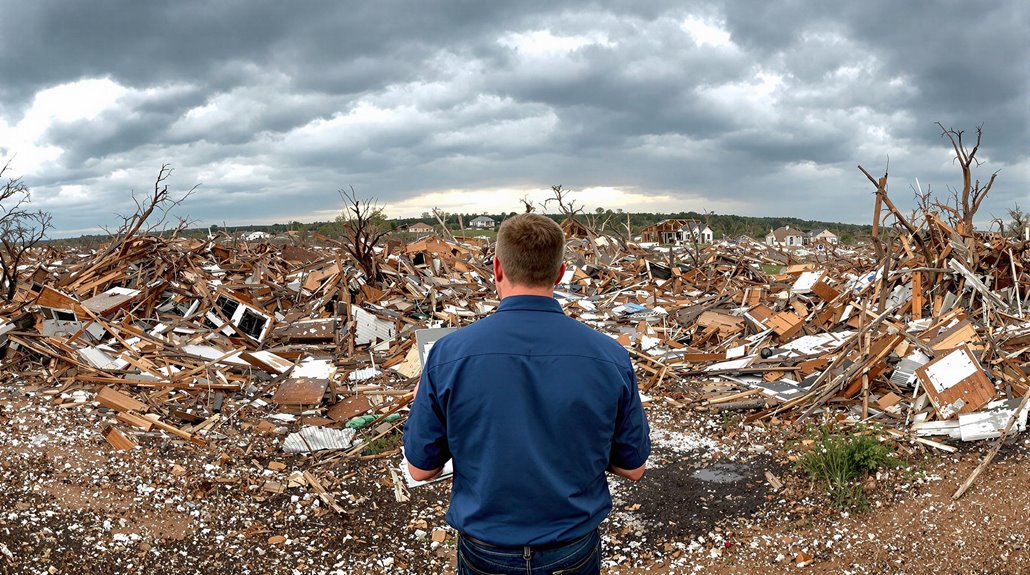
Following an EF4 tornado, public adjusters provide critical expertise in maneuvering complex insurance claims through objective damage assessments and extensive documentation processes.
These licensed professionals streamline communications with insurance carriers while ensuring all damage is properly identified, documented, and included in claim submissions.
Statistical evidence indicates that claims handled by public adjusters often result in notably higher settlements, with studies showing increases of up to 747% in catastrophic loss situations compared to policyholder-handled claims.
Most public adjusters charge 10% to 20% of the final settlement amount, with fees potentially higher for catastrophic claims like tornado damage.
Expertise In Insurance Claims
When maneuvering through the complex aftermath of an EF4 tornado, consulting a public adjuster offers significant advantages in managing insurance claims effectively.
These professionals possess extensive knowledge of insurance policy interpretation and facilitate claims process efficiency through their expertise in documentation and negotiation.
Public adjusters provide essential support through:
- Detailed analysis of policy coverage and exclusions
- Professional documentation of tornado-related damages
- Strategic presentation of claims to insurance carriers
- Expert negotiation for maximum settlement value
Their thorough understanding of state-specific regulations and complex claim procedures guarantees accurate interpretation of policy terms.
Public adjusters handle all aspects of the claims process, from initial documentation to final settlement, while maintaining professional communication with insurance carriers.
This systematic approach optimizes claim outcomes and reduces processing timeframes, particularly vital in catastrophic tornado damage scenarios.
Working on a contingency fee basis, public adjusters typically charge between 5-20% of the final settlement amount, making their services accessible to most policyholders.
Objective Damage Assessment
The objective assessment of tornado damage demands meticulous evaluation by qualified professionals who understand both structural engineering principles and insurance protocols.
Licensed public adjusters perform thorough damage evaluation that extends beyond surface-level examination to identify concealed vulnerabilities and structural compromises.
These professionals utilize the Enhanced Fujita (EF) Scale's systematic approach, analyzing specific Damage Indicators (DI) and Degrees of Damage (DoD) to quantify the tornado's impact.
Their expertise in claim documentation guarantees that all damages are properly recorded and substantiated, from visible destruction to hidden structural weaknesses.
This methodical process translates complex damage patterns into detailed reports that effectively communicate the full scope of losses to insurance carriers, facilitating accurate compensation for property restoration.
Working with public adjusters' expertise often results in higher settlement amounts compared to initial offers from insurance company adjusters.
Streamlined Claim Process
Engaging a licensed public adjuster greatly streamlines the tornado damage claims process through systematic management of documentation, negotiations, and procedural requirements. Their claim strategy incorporates thorough damage assessment protocols while managing all communications with insurance carriers, greatly reducing administrative burden on policyholders.
Professional adjusters execute critical process components through:
- Thorough documentation of structural and content damages
- Expert interpretation of policy coverage parameters
- Strategic negotiation with insurance representatives
- Systematic organization of claim evidence and supporting materials
This systematic approach enables policyholders to focus on recovery while ensuring best claim outcomes.
Public adjusters handle all technical aspects including deadline management, dispute resolution, and settlement negotiations, providing expert advocacy throughout the entire claims process while maintaining adherence to insurance industry standards and regulations.
With typical settlements increasing significantly, public adjusters' expertise in negotiation and documentation often justifies their 5-15% commission fees through higher claim payouts.
Higher Claim Payouts & Settlements
Professional consultation with public adjusters consistently yields measurably higher claim settlements through expert damage assessment protocols and strategic negotiation methods.
Their specialized knowledge of insurance policy intricacies enables thorough documentation of both visible and concealed damages, ensuring maximum claim valuation.
Public adjusters employ advanced claim negotiation strategies, often collaborating with forensic accountants and building estimators to strengthen settlement positions.
Their expertise in identifying overlooked damages and understanding insurance company tactics proves instrumental in securing ideal compensation.
Statistical evidence demonstrates that professionally managed claims typically result in substantially higher settlements compared to policyholder-managed claims.
Additionally, these specialists effectively handle business interruption claims, accounting for revenue losses while streamlining the entire claims process through systematic documentation and strategic communications with insurers.
Members of the PCAN network must maintain strict ethical standards and undergo regular audits to ensure the highest level of professionalism in claims handling.
About The Public Claims Adjusters Network (PCAN)

Public Claims Adjusters Network (PCAN) operates as a thorough claims management organization, combining experienced daily and catastrophe adjusters with professional call center staff to deliver end-to-end insurance claim solutions.
The network emphasizes customized service delivery, addressing unique operational challenges while maximizing claim outcomes through proven expertise and decades of industry experience.
Key public adjuster benefits through PCAN include:
- Professional assessment and validation of property damage claims
- Extensive policy coverage review and interpretation
- Direct negotiation with insurance companies for ideal settlements
- Immediate support through dedicated call center communications
PCAN maintains strict compliance with regulatory requirements, including mandatory notification to insurers within 48 hours of contract execution and written communication of settlement offers within five business days.
Their claims management approach integrates technical expertise with efficient processing systems, resulting in documented success rates and increased claim settlements for policyholders affected by catastrophic events such as EF4 tornadoes.
Frequently Asked Questions
Can Tornadoes Change Strength During Their Lifetime From EF4 to Another Rating?
Research demonstrates tornado strength fluctuations occur frequently during their lifecycle, with documented cases showing EF4 tornadoes shifting between different intensity ratings based on observable damage patterns and wind speed estimates.
What's the Average Time Between First Sighting and Touchdown of EF4 Tornadoes?
While tornado tracking indicates the average warning lead time is 22.1 minutes, precise data for EF4-specific first sighting to touchdown intervals through storm spotting remains statistically uncertain due to rapid formation dynamics.
How Do Insurance Companies Specifically Handle EF4 Tornado Damage Claims?
Insurance companies assess EF4 tornado damage through systematic claim processes, evaluating structural integrity, documenting evidence, and analyzing wind-speed indicators before determining appropriate coverage levels and compensation amounts.
Do EF4 Tornadoes Occur in Other Countries Besides the United States?
International tornadoes of EF4 intensity have occurred in multiple countries, including Canada, Russia, Poland, Denmark, Italy, Argentina, and Brazil, though documented tornado occurrences are less frequent than U.S. cases.
What Percentage of EF4 Tornadoes Occur at Night Versus During Daylight?
While specific data on EF4 nighttime occurrences versus daylight frequency is not directly provided in the background information, tornadoes overall are 27.3% nocturnal, with violent tornadoes showing higher nighttime prevalence.
References
- https://www.factsjustforkids.com/weather-facts/ef4-tornado/
- https://www.ready.gov/tornadoes
- https://papersowl.com/examples/understanding-the-power-and-impact-of-ef4-tornado-wind-speeds/
- https://rainbowrestores.com/blog/what-is-the-fujita-scale
- https://www.mass.gov/info-details/tornado-safety-tips
- https://en.wikipedia.org/wiki/List_of_F4
- https://www.spc.noaa.gov/faq/tornado/f-scale.html
- https://en.wikipedia.org/wiki/EF4
- https://en.wikipedia.org/wiki/Tornado_intensity
- https://www.weather.gov/mkx/taw-tornado_classification_safety

